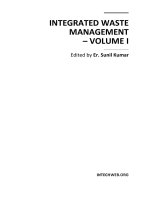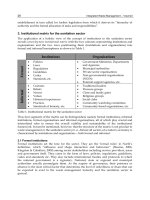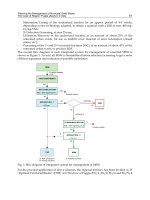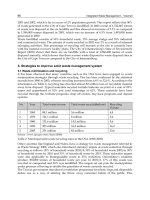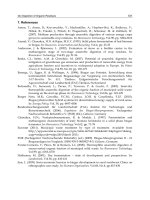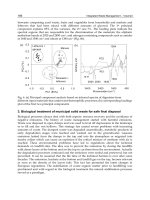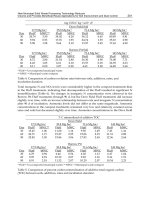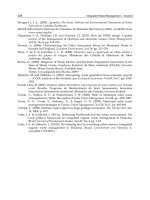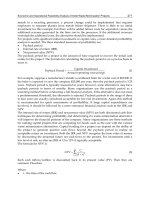Integrated Waste Management Volume II Part 1 pot
Bạn đang xem bản rút gọn của tài liệu. Xem và tải ngay bản đầy đủ của tài liệu tại đây (2.15 MB, 35 trang )
INTEGRATED WASTE
MANAGEMENT
– VOLUME II
Edited by Er. Sunil Kumar
Integrated Waste Management – Volume II
Edited by Er. Sunil Kumar
Published by InTech
Janeza Trdine 9, 51000 Rijeka, Croatia
Copyright © 2011 InTech
All chapters are Open Access articles distributed under the Creative Commons
Non Commercial Share Alike Attribution 3.0 license, which permits to copy,
distribute, transmit, and adapt the work in any medium, so long as the original
work is properly cited. After this work has been published by InTech, authors
have the right to republish it, in whole or part, in any publication of which they
are the author, and to make other personal use of the work. Any republication,
referencing or personal use of the work must explicitly identify the original source.
Statements and opinions expressed in the chapters are these of the individual contributors
and not necessarily those of the editors or publisher. No responsibility is accepted
for the accuracy of information contained in the published articles. The publisher
assumes no responsibility for any damage or injury to persons or property arising out
of the use of any materials, instructions, methods or ideas contained in the book.
Publishing Process Manager Romina Krebel
Technical Editor Teodora Smiljanic
Cover Designer Jan Hyrat
Image Copyright Hasloo Group Production Studio, 2010. Used under license from
Shutterstock.com
First published August, 2011
Printed in Croatia
A free online edition of this book is available at www.intechopen.com
Additional hard copies can be obtained from
Integrated Waste Management – Volume II, Edited by Er. Sunil Kumar
p. cm.
ISBN 978-953-307-447-4
free online editions of InTech
Books and Journals can be found at
www.intechopen.com
Contents
Preface IX
Part 1 Planning and Social Perspectives
Including Policy and Legal Issues 1
Chapter 1 Operationalising Municipal Solid Waste Management 3
Peterson Obara Magutu and Cliff Ouko Onsongo
Chapter 2 Status of Waste Management 11
Dennis Iyeke Igbinomwanhia
Chapter 3 Municipal Solid Waste Management in
Developing Countries: Future Challenges
and Possible Opportunities 35
Imad A. Khatib
Chapter 4 International Practices in Solid Waste Management 49
Rafia Azmat
Chapter 5 Key Areas in Waste Management:
A South African Perspective 69
Mosidi Makgae
Chapter 6 Exploring and Assessing Innovative Approaches to
Utilizing Waste as a Resource: Toward Co-Benefits 83
Xudong Chen, Tsuyoshi Fujita, Yong Geng and Fengming Xi
Chapter 7 Big Game Waste Production:
Sanitary and Ecological Implications 97
Joaquín Vicente, Ricardo Carrasco, Pelayo Acevedo,
Vidal Montoro and Christian Gortazar
Part 2 Processing of Solid Waste 129
Chapter 8 Vermicomposting 131
Roohalah Rostami
VI Contents
Chapter 9 Animal Manure as Alternatives to Commercial
Fertilizers in the Southern High Plains of the United
States: How Oklahoma Can Manage Animal Waste 143
J.D. Vitale, C. Penn, S. Park, J. Payne, J. Hattey and J. Warren
Chapter 10 Emerging Issues on Urban Mining in Automobile Recycling:
Outlook on Resource Recycling in East Asia 165
Jeongsoo Yu, Jia Che, Michiaki Omura and Kevin Roy B. Serrona
Chapter 11 Phosphorus in Water Quality and Waste Management 181
Helmut Kroiss, Helmut Rechberger and Lukas Egle
Chapter 12 Anaerobic Processes for Waste Treatment
and Energy Generation 215
Melanie Sattler
Chapter 13 Management of Phosphorus Resources –
Historical Perspective, Principal Problems
and Sustainable Solutions 247
Yariv Cohen, Holger Kirchmann and Patrik Enfält
Chapter 14 On-Farm Composting of Dead Stock 269
Kevin G Wilkinson
Chapter 15 Recycling of Printed Circuit Boards 285
Maria Paola Luda
Part 3 Industrial Solid Waste 299
Chapter 16 Recycling of Waste Paper Sludge in Cements:
Characterization and Behavior of New
Eco-Efficient Matrices 301
Moisés Frías, Iñigo Vegas, Raquel Vigil de la Villa
and Rosario García Giménez
Chapter 17 Agroindustrial Wastes as Substrates for
Microbial Enzymes Production and Source
of Sugar for Bioethanol Production 319
Daniela Alonso Bocchini Martins, Heloiza Ferreira Alves do Prado,
Rodrigo Simões Ribeiro Leite, Henrique Ferreira, Márcia Maria de
Souza Moretti, Roberto da Silva and Eleni Gomes
Chapter 18 Are WEEE in Control? Rethinking Strategies for Managing
Waste Electrical and Electronic Equipment 361
Francis O. Ongondo and Ian D. Williams
Chapter 19 Preliminary Study of Treatment of Spent Test Tubes
Used for Blood Tests by Acidic Electrolyzed Water 381
Masafumi Tateda, Tomoya Daito, Youngchul Kim
and B.C. Liyanage Athapattu
Contents VII
Chapter 20 (Re-)constructing Nuclear Waste Management in Sweden:
The Involvement of Concerned Groups, 1970–2010 401
Jonas Anshelm and Vasilis Galis
Chapter 21 Assessment of the Vulnerability Potential for an
Unconfined Aquifer in Konya Province, Turkey 431
M. Tahir Nalbantcilar
Part 4 Leachate and Gas Management 439
Chapter 22 Sustained Carbon Emissions Reductions through Zero
Waste Strategies for South African Municipalities 441
Cristina Trois and Rohini Jagath
Chapter 23 Greenhouse Gas Emission from Solid
Waste Disposal Sites in Asia 461
Tomonori Ishigaki, Osamu Hirata, Takefumi Oda,
Komsilp Wangyao, Chart Chiemchaisri,
Sirintornthep Towprayoon, Dong-Hoon Lee and Masato Yamada
Preface
The quantum of wastes generated in urban centres has become one of the difficult
tasks for those responsible for their management. The problem is becoming acute
specially in economically developing countries, where there is a financial crunch, and
other resources are scarce.
Although there are varieties of publications dealing with various topics of solid waste
management, most of these documents have been published addressing the needs of
developed nations. Only a few documents have been specifically written to provide
the type of information that is required by those in developing countries. In addition,
most of the documents are not accessible to all the readers, and there is also a strong
need to update the published documents once again in view of globalization. To
maximize the use of limited available resources, it was decided to combine
information gathered from both developed and developing countries on all the
elements of solid waste management under the title “Integrated Waste Management”.
Due to overwhelming response from authors all around the world, the book has been
divided into two parts, i.e. Volume I and II, and the chapters have been grouped under
different sub-headings.
This publication has been prepared primarily for researchers, engineers, scientists,
decision-makers and policy makers involved in the management of solid wastes. The
information provided in both the volumes would also be useful to students studying
environmental science and engineering.
Er. Sunil Kumar
Scientist
Council of Scientific and Industrial Research (CSIR)
National Environmental Engineering Research Institute (NEERI)
Kolkata Zonal Laboratory
Kolkata
India
Part 1
Planning and Social Perspectives
Including Policy and Legal Issues
1
Operationalising Municipal
Solid Waste Management
Peterson Obara Magutu
1
and Cliff Ouko Onsongo
2
1
University of Nairobi
2
Inoorero University
Kenya
1. Introduction
A municipality is an administrative division composed of a defined territory and population
(Al-Salem and Lettieri, 2009). While there are many varieties of municipalities, most fall into
one of two categories: a single settlement and a land area similar to a township that may
contain multiple settlements, or even just part of one, such as a city's municipality.
Municipal Solid Waste (MSW) can be defined as solid waste which includes all domestic
refuse and non-hazardous wastes such as commercial and institutional wastes, street
sweepings and construction debris (Magutu et al., 2010). The major types of MSW are food
wastes, paper, plastic, rags, metal and glass, with some hazardous household wastes such as
electric light bulbs, batteries, discarded medicines and automotive parts. MSW is thus seen
as primarily coming from households but also includes wastes from offices, hotels,
shopping complexes/shops, schools, institutions, and from municipal services such as street
cleaning and maintenance of recreational areas. In some countries the solid wastes
management system also handles human wastes such as night-soil, ashes from incinerators,
septic tank sludge and sludge from sewage treatment plants. The complexities and enormity
of the challenges become evident when considering other waste types to be managed and
these include industrial solid waste, municipal wastewater, industrial wastewater, storm
water and hazardous waste.
This chapter will focus on the major ways of managing the Municipal Solid Waste,
especially through the proper long-term strategies by looking at the following four key
areas: Formulation of the municipal solid waste management strategy; Objectives of
municipal solid waste management; Waste management strategies used in municipal solid
waste management; and lastly the challenges facing the implementation of sound municipal
solid waste management strategies
2. Municipal solid waste
Municipal Solid Waste (MSW) can be defined as solid waste which includes all domestic
refuse and non-hazardous wastes such as commercial and institutional wastes, street
sweepings and construction debris. In some countries the solid wastes management system
also handles human wastes such as night-soil, ashes from incinerators, septic tank sludge
and sludge from sewage treatment plants. If these wastes manifest hazardous characteristics
they should be treated as hazardous wastes (UNEP, 2005).
Integrated Waste Management – Volume II
4
Waste management practices differ for developed and developing nations, for urban and
rural areas, and for residential and industrial producers. MSW is thus seen as primarily
coming from households but also includes wastes from offices, hotels, shopping
complexes/shops, schools, institutions, and from municipal services such as street
cleaning and maintenance of recreational areas. Residential and commercial types of solid
waste include food wastes, paper, cardboard, plastics, textiles, glass, metals, and ashes,
special wastes like bulky items, consumer electronics, batteries, oil, tires and household
hazardous wastes. Institutions types of solid waste include
paper, cardboard, plastics,
wood, food wastes, glass, metals, special wastes, hazardous wastes. Municipal services
types of solid waste include Street sweepings, landscape and tree trimmings, general
wastes from parks, beaches, and other recreational areas. Therefore, the major types of
MSW are food wastes, paper, plastic, rags, metal and glass, with some hazardous
household wastes such as electric light bulbs, batteries, discarded medicines and
automotive parts (UNEP, 2005; UNEP, 2004).
In recent years the volume of waste has been increasing at an alarming rate, posing a
formidable challenge to governments (Magutu et al., 2010). The complexities and enormity
of the challenges become evident when considering other waste types to be managed and
these include industrial solid waste, municipal wastewater, industrial wastewater, storm
water and hazardous waste. Often, different government agencies are mandated to manage
different waste sectors. This fragmented approach to waste management, coupled with a
lack of clear definition and delineation of the different waste types, makes an assessment of
current waste management practices in most countries difficult (UNEP, 2005).
2.1 Waste management strategies used in municipal solid waste management
Waste management is the collection, transport, processing, recycling or disposal, and
monitoring of waste materials. Operations strategy can be viewed as part of a planning
process that coordinates operational goals with those of the larger organization. Since the
goals of the larger organization change over time, the operations structure must be
designed to anticipate future needs. The operations capabilities of a firm can be viewed as
a portfolio best suited to adapt to the changing product and service needs of a firm’s
customers (Hayes, 1985).
The costs for solid waste management are high especially for collection, transportation,
treatment and disposal, which are largely borne by city councils. Methods of collection of
waste are either door-to-door or using containers or communal bins. All medium and large
cities have administrative structures for providing collection services but often, cities in
developing countries use non-compaction trucks for daily collection, with a few cities using
compaction trucks and hauling trucks. The most common municipal waste management
practices include: recycling/recovery, composting, incineration and land filling/open
dumping. The operations strategy is a very important tool in the solid waste management
practices and processes (Peters, 1984).
MSW may contain the following materials, which are considered recyclables: ferrous and
non-ferrous metals, construction debris, scrap tires, paper/cardboard, plastics, textiles
(including cloth and leather), glass, wood/timber, animal bones/feathers, waste oil and
grease, cinders/ashes. In the middle-to-low-income cities, there exists a long-standing
practice of informal source separation and recycling of materials (Magutu et al., 2010). This
has led to the development of enterprises for the gathering, trading and reprocessing of
Operationalising Municipal Solid Waste Management
5
materials. For example Mukuru Recycling project which started in 1991 to help men and
women scavengers sell recyclable waste to industries. The national ministries support waste
recovery and recycling activities at city level although many of these are family businesses.
However, since industries would only be interested to use recycled materials when they cost
less than the virgin materials, the practice of recycling is so market-driven that recycling has
become selective. The disposal of those unselected recyclables remains a problem.
Informal waste separation or waste picking takes place in three ways: At source - this is in
large urban areas, e.g., commercial areas or residential areas with apartments/high-rise
buildings for high income earners. Here waste pickers sort out the waste before the authorized
collection vehicle arrives. During collection, when the collectors segregate recyclable materials
during loading and store them inside the truck or on the sides of the vehicles. At the disposal
site – where the waste pickers often live on or near the dumps. However, they risk the danger
of potential slides and fires. While waste picking means survival for waste pickers the methods
of uncontrolled waste picking can reduce the efficiency of the formal collection system and can
be detrimental to health due to exposure to biological pathogens.
Composting is not well practiced. Waste materials that are organic in nature, such as plant
material, food scraps, and paper products, can be recycled using biological composting and
digestion processes to decompose the organic matter (Al-Salem and Lettieri, 2009). The
resulting organic material is then recycled as mulch or compost for agricultural or
landscaping purposesHousehold organic wastes, including wastes from the restaurants, are
often collected for animal feed. But these are either not working or are not operating at full
capacity for a number of reasons, such as: High operating and maintenance costs, poor
maintenance and operation of facilities, Incomplete separation of non-compostables, such as,
plastics and glass, high cost of compost compared to commercial fertilizers.
Another waste treatment method that is practiced is incineration where 90 percent of non-
recyclable municipal solid waste is incinerated. Final disposal of waste is at landfills where
10 percent of non-recyclable municipal solid waste is deposited (Al-Salem and Lettieri,
2009). Singapore has four government-owned and operated incinerators for the disposal of
solid waste that is not recycled. However, controversy remains over the soundness of
incineration as a waste treatment technology because of greenhouse gas emissions from
incinerators. Incineration has been completely banned under the new law on solid waste
management (Rio de Janeiro, 1992). The practice of informal incineration or open burning is,
however, still prevalent, not only in the rural areas where waste collection is rare but also in
peri-urban and urban areas.
The popular meaning of ‘recycling’ in most developed countries refers to the widespread
collection and reuse of everyday waste materials such as empty beverage containers. These
are collected and sorted into common types so that the raw materials from which the items
are made can be reprocessed into new products. Material for recycling may be collected
separately from general waste using dedicated bins and collection vehicles, or sorted
directly from mixed waste streams.
Landfills are generally the cheapest and most common disposal method for municipal solid
waste (Al-Salem and Lettieri, 2009). Disposing of waste in a landfill involves burying the
waste, and this remains a common practice in most countries. Landfills were often
established in abandoned or unused quarries, mining voids or borrow pits. A properly
designed and well-managed landfill can be a hygienic and relatively inexpensive method of
disposing of waste materials. Older, poorly designed or poorly managed landfills can create
Integrated Waste Management – Volume II
6
a number of adverse environmental impacts such as wind-blown litter, attraction of vermin,
and generation of liquid leachate. An exception is a large city like Singapore, which faces
rising disposal costs due to exhaustion of traditional disposal sites, stricter environmental
controls and greater waste quantities, thus requiring other methods like incineration to
reduce the volume of waste for final disposal. In the other developing countries, open
dumping is the common practice, i.e., municipal solid waste is dumped on swamplands and
low-lying areas, which are eventually reclaimed for development. The problems associated
with landfills, even with those that are clay-lined, include high water table, groundwater
contamination and gas migration.
Incineration is a disposal method in which solid organic wastes are subjected to combustion
so as to convert them into residue and gaseous products. This method is useful for disposal
of residue of both solid waste management and solid residue from waste water
management (Al-Salem and Lettieri, 2009). This process reduces the volumes of solid waste
to 20 to 30 percent of the original volume. Incineration and other high temperature waste
treatment systems are sometimes described as "thermal treatment". Incinerators convert
waste materials into heat, gas, steam and ash. Incineration is common in countries such as
Japan where land is more scarce, as these facilities generally do not require as much area as
landfills. Waste-to-energy (WtE) or energy-from-waste (EfW) are broad terms for facilities
that burn waste in a furnace or boiler to generate heat, steam and/or electricity.
2.2 Formulation of the municipal solid waste management operations strategy
Operations strategy is the “HOW” in any corporate and market strategy. Operations
strategy is no longer a tool for continuous improvement and sustainable competitive
advantage in the manufacturing sector only, since it can be now applied in the service
industry and public organizations.
The operation strategies used in solid waste management can be modeled using a process
chart as follows:
From the model, the formulation of organizational strategy must be done by the CEO and
the employees through selected committees. The formulation of organizational strategy
should be followed by setting of Annual Objectives in Solid Waste Management. The annual
objectives includes to: improve public health of the people; improve the environment; and
maintain public cleanliness in order to keep public places aesthetically acceptable; by
ensuring the proper storage, collection, transportation, safe treatment and disposal of solid
waste. This driven by the annual departmental objectives designed according to the
department of environment’s major mandates. They are derived from annual departmental
objectives especially by the departmental heads and the employees. This is operational Level
(origination of Annual Objectives in Solid Waste Management). The policies adequately
support the institutions strategic plan: the departmental organizational structure support
implementation of strategy; and the procedures/regulations followed by the departments
are supportive of change implementation. This should be documented in the current
strategic plan (Magutu et al., 2010).
There are so many factors that can enable an organization to take a fresh look at its
operations Strategy. The different factors that impact on the operations strategy are: most
managers felt that the emergence of aggressive and highly competent competitors,
demanding and environmentally conscious customers. Other secondary factors include:
advances in production and information technology, global business operations, business
process re-engineering techniques and the enormous opportunities for operational
Operationalising Municipal Solid Waste Management
7
Fig. 1. Formulation of Strategies Used In Municipal Solid Waste Management
Integrated Waste Management – Volume II
8
efficiencies and economies. The external environment of the municipality’s trends in the
market; changes in customer wants and expectations (demanding speed of delivery, high
quality, and low price); Identifying the company’s strengths, special skills of workers, such
as expertise in providing customized services or knowledge of information technology; the
trends in the political environment changes in the political climate—local, national, and
international) and forming partnerships with international firms(Magutu et al., 2010).
Investment on scanning the environment of operation before developing the solid waste
management operations strategy is important. As one invests on time and effort in
implementing its operations strategy after the environmental scanning and formulation of
operations strategy, there is need to invest in its implementation. There are a number of
challenges which needs to be managed during the implementation of operations strategy
with respect to solid waste management. The factors considered to have a strongly effect on
the municipal solid waste strategy implementation include: Inability to formulate and
implement sound solid waste management policies, Inadequate treatment and disposal of
solid waste; Inadequate landfill disposal, Poor formulation and enforcement of laws and
regulations relating to solid waste management; Poor services for solid waste collection and
Limited utilization of recycling activities; the Inability to regulate and monitor the activities
of all generators of solid waste, and Poor transportation services provision. The secondary
challenges include: The deficient accounting systems ; Dumping along the back lanes and
street corners within the city and its suburbs; High risk of environmental pollution;
Inadequate service coverage and operational inefficiencies of service; Large amounts of
uncollected solid waste; Lack of adequate and appropriate staff ; Inadequate management of
hazardous and healthcare waste; No controls from the management side to prevent toxic
and even hazardous waste; Very inadequate billing systems (Magutu et al., 2010).
This proper management of the challenges finally leads to proper solid waste management.
3. Success stories in solid waste management
Rapid urbanization and the associated growth of industries and services is an essential
feature of economic and demographic development in most developing countries. Cities are
currently absorbing two-thirds of the total population increase throughout the developing
world (UNCHS, 1993). Another striking growth is the steady growth in size of cities. One of
the most important environmental consequences of urbanization is the amount of solid
waste that is generated. These wastes have fast outstripped the ability of natural
environment to assimilate them and municipal authorities to dispose of them in a safe and
efficient manner. The resulting contamination affects all environmental media and has a
direct negative effect on human health and the quality of urban life.
Most governments all over the world where waste management services have successfully
been done subsidizes the budgets for solid waste management up-to over 60 percent. In
Japan for example before privatization of solid waste management services, government
subsidy to SWM used to be 80 percent while in Sweden it is 70 percent despite residents still
paying an equivalent of kshs 800 per month for the solid waste management services. Accra
in Ghana, residents pay up to Kshs 700 per month for the solid waste management services.
Singapore has a collection rate of more than 90 percent while in Bangkok, Jakarta and Kuala
Lumpur the rate is more than 80 percent. In Indonesia, collection rates have been improved
through a pre-collection system at villages, which deposit their municipal solid waste at
transfer or temporary storage facilities (Rio de Janeiro, 1992).
Operationalising Municipal Solid Waste Management
9
In Dar es Salaam in Tanzania, the government made a bold step in 1994 to privatize the
waste collection and transportation aspects where the city was zoned and different private
companies were given areas of operation while collecting waste management charges
approved by the various municipalities. Different municipalities enacted their own by-laws
to govern and guide the operations of the private sector. The City only manages the disposal
site but this again, the city of Dar-es-salaam has partnered with a strategic investor from
Germany to develop a sanitary landfill site as for a long time the city has operated with a
controlled disposal site. The private companies collect waste management charges from the
citizens and only approved rates by the council are applied. The city has a department for
solid waste disposal, which only develops policies, rules governing the private sector
operation, supervision and the management of the disposal site. The private companies
contracted are locals and sometimes they get a back- up from the city council whenever they
cannot deliver. In this case, the council has to have what to fall back to and therefore the
council cannot afford at any time to have no fleet of vehicles (Rio de Janeiro, 1992).
In Cairo Egypt, the Government decided to invite international bidders for the solid waste
management services when the council failed to provide the required services and the city
was dirty while the residents were not agreeable to pay for services, which were hardly
there in 2002. The Giza region in Cairo, which has a population of 6.5 million was divided
into three zones and contracted to three different companies. Jacorossi Impresse is one of the
companies managing cleansing services from a population of about 1.2 million under a 15 yr
period contract (Rio de Janeiro, 1992).
4. Conclusion
Solid waste management or municipal solid waste management varies widely among
different countries and regions. Most of the management services are often provided by
local government authorities, or by private companies in the industry. This can be done
through The application of waste hierarchy which refers to the "3 Rs" reduce, reuse and
recycle. This hierarchy classifies waste management strategies according to their desirability
in terms of waste minimization aimed at extracting the maximum practical benefits from
products and to generate the minimum amount of waste. The Extended Producer
Responsibility (EPR) is a strategy designed to promote the integration of all costs associated
with products throughout their life cycle including end-of-life disposal costs into the market
price of the product. The other strategy is Polluter Pays Principle, where the polluting party
pays for the impact caused to the environment, which implies that a waste generator pays
for appropriate disposal of the waste.
5. References
Al-Salem S.M. and Lettieri P., (2009), “Life Cycle Assessment (LCA) of Municipal Solid
Waste Management in the State of Kuwait” European Journal of Scientific
Research, ISSN 1450-216X Vol.34 No.3 (2009), pp.395-405
Hayes RH. 1985. Strategic Planning: Forward In Reverse? Harvard Business Review 63(6):
67–77.
Magutu O.P, Mbeche M.I, Nyamwange O.S, Mwove M. & Ndubai E.R., 2010, “Formulation
and Implementation of Operation Strategies Used in Solid Waste Management:
Case Study of City Council of Nairobi” IBIMA Publishing Vol. 2010 (2010), 842702,
Integrated Waste Management – Volume II
10
Journal of African Research in Business & Technology, 21 pages: available on-line
at www.ibimapublishing.com/journals/JARBT/2010/842702/842702.pdf
Peters, T. J. , 1984, In Search of Excellence: Lessons from America’s Best Run Companies. New
York: Warner Books.
Rio de Janeiro, 1992, "Environmentally Sound Management of Solid Wastes and Sewage-
related Issues" in the United Nations Conference on Environment and
Development, Chapter 21.3 of Agenda 21
UNEP (2004) The Use of Economic Instruments in Environmental Policy: Opportunities and
Challenges, UNEP, Geneva.
UNEP (2005) Selection, Design and Implementation of Economic Instruments in the Solid Waste
Management Sector in Kenya: The Case of Plastic Bags, UNEP-ETB, Geneva. IN “
United Nations Conference of Environment and Development, 1992 – Agenda 21”
2
Status of Waste Management
Igbinomwanhia, Dennis Iyeke
Mechanical Engineering Department
University of Benin, Benin City,
Nigeria
1. Introduction
Solid waste management problem appears to be the most prominent in urban cities and
large towns across the world due to the huge quantity of solid waste generated from
domestic and commercial activities. In most cities and large towns of the world, solid waste
is not only heaped in huge quantities on refuse dumps but also thrown and made to lie
around in piles in the street and in small illegal dump on any piece of unused land. Most
third world countries have worst cases than industrialised countries which have the money,
technical knowhow and public attitudes to control and manage their waste to some degree.
This chapter presents a practical approach to the assessment of the Status of Solid waste
management with application in Nigeria. The objectives of the chapter are discussed as
follows:
1.1 Solid waste characterisation
Waste characterization is a waste stream analysis which involves a logical and systematic
approach to obtaining and analyzing data on one or more waste streams or sub-streams.
Waste characterization provides an estimate of solid waste quantity and composition. Two
commonly use method of waste characterization are – material flow approach and site-
specific study. However there is currently no agreed international standard for waste stream
analysis or waste characterisation although many countries have national procedures for
analyzing their waste. Waste characterization has been developed and discussed in this
chapter.
1.2 Assessment of the solid waste chain
Waste management in all ramifications, is simply a planned system aimed at effectively
controlling the production, storage, collection, transportation, processing and disposal of
waste. Waste management is an important element of environmental protection. Its purpose
is to provide hygienic, efficient and economic solid waste storage, collection, transportation
and treatment or disposal of waste without polluting the atmosphere, soil or water system.
The various steps involved in the management of solid waste from generation to the point of
sanitary disposal are referred to as solid waste chain. It therefore means that the solid waste
chain is the path trace by solid waste from generation to the final disposal point. The solid
waste chain has been extensively discussed in this work
Integrated Waste Management – Volume II
12
1.3 Assessment of the status of source segregation
The process of recovery is the main task in the Solid waste Management Mix that is
sustainable. Waste sorting is a major part of sustainable solid waste management process
because if the wastes are sorted correctly, about 30 - 50% of the work is done. The solid
waste source sorting process has also been presented in this work.
1.4 Existing legislation for waste management
Various policy initiatives are required in alleviating the urban solid waste management
problems. Policy initiative has been review as it applies in Nigeria
1.5 Review of the institutional and funding aspect of waste management
The institutional framework and funding are aspects of the most important requirements for
improved solid waste management. The status of institutional framework and funding of
solid waste management has been examined and presented with respect to Nigeria.
This presentation will not be meaningful without feasible suggestions of strategies for
improved urban solid waste management system. Suggestions have therefore been
presented in this work.
2. Definitions of waste
Waste is a term generally used to describe the materials we throw away. In the United state
of America it includes objects the lay audience commonly calls garbage, refuse and trash
(Davis and Masten, 2004). The oxford advance dictionary defined waste as unused materials
or substance produced while making something. Another dictionary – the word net
dictionary defined waste as any material unused and rejected as worthless or unwanted.
Waste may also be defined simply as left-over, or already used items waiting for reuse or
disposal (Audu, 2007). In addition another definition state thus, waste is any unwanted
material intentionally thrown away for disposal (Hoornweg, 1999).
The problem with these definitions is that for any material to be a waste it must be thrown
away for disposal. Not all wastes are thrown away for disposal. A lot of wastes are kept by the
owner for sale which becomes useful raw materials to other persons. The dictionary meaning
and other definitions stated above when carefully examined, rely too much on other terms
(such as garbage, trash, refuse etc), which do not provide a means to determine whether a
given particle, material or item is not a waste based on its composition and its instantaneous
relationship to an owner, a generator, a recycler or a legal designation (Palmer, 1992).
As a follow-up to this, Palmer (1992) proposed the following prescriptive definition of waste
which expressed in concise form the critical properties of waste which make it a subject of
importance by presenting the instantaneous relationship to the owner. “Waste is any object
whose owner does not want to take responsibility for it”. (Palmer, 1992)
A careful examination of this definition will show that this definition is of the type, which
depends on the relationship with an owner. Without an identified owner an object may not be
considered in terms of waste. This definition shows that the first step in discussing waste is to
locate and identify an owner. This implies that anything without an owner is a waste. If it is
potentially valuable an owner will emerge Palmer (1992). However any object which acquires
a new owner, who wishes to take responsibility for it, is not a waste, no matter what history.
Another definition states thus “waste is a material which has served its original intended
use and sometime discarded.” The problem with this kind of definition is that it is
Status of Waste Management
13
unforgiving. Any material which once had another use is now a waste no matter that it is
brand new, clean and valuable, much less perfectly recyclable if given a little attention.
Waste is also seen as "any material which the holder discards, is obliged to discard or
intends to discard". It has an objective element in the sense that a material becomes waste by
virtue of a circumstance which is outside the control of the owner or holder of the material;
namely the fact of abandoning the material or the fact that there are provisions which
determine that certain material is to be classified as waste. (Melissa, 2005)
The USEPA, regulatory definition is broader in scope. It defines solid waste thus “solid
waste include any discarded item, things destined for reuse, recycling, or reclamation,
sludge and hazardous waste. The regulatory definition specifically excludes radioactive
waste and in situ mining waste (Davis and Masten, 2004).
2.1 Proposed definition
Having examined the definition given by various authors as shown above it became clear
that they are not all encompassing hence there is need to propose a definition that can define
waste more broadly as follows: “Any object that may or may not have served its intended
use and the owner is not ready to continue to take responsibility for ownership and or
continuing to keep it and he or she is ready to discard it if possible is a waste”.
Waste may be asset or a liability depending on the management system applied on it. To the
developed countries wastes are asset because they have the technology and public attitude
that help the nations to reverse the state of their waste which make it become assets instead of
liability. Take for example, the recycling of waste paper save trees use for making fresh pulps.
In this chapter the status of municipal solid waste management has been discussed with a case
study in developing country - Nigeria. The study covered the nature and quantities of
municipal waste generated, the availability of technology for handling and processing, the
degree of industrialisation in terms of extent of mechanisation and availability of technological
resources, perception and attitude to solid waste management.
3. Municipal solid waste
Municipal solid waste (MSW) is defined Cointreau (1982) as non-air and sewage emissions
created within and disposed of by a municipality, including household garbage, commercial
refuse, construction and demolition debris, dead animals, and abandoned vehicles.
Municipal solid waste is generally made up of paper, vegetable matter, plastics, metals,
textiles, rubber, and glass (USEPA 2002). Municipal solid waste disposal is a major concern
in developing countries across the world, as high poverty, population growth, and high
urbanization rates combine with ineffectual and under-funded governments hampers
efficient management of wastes (Doan 1998, Cointreau 1982). In most cities and large towns
of developing countries, solid waste is not only heaped in huge quantities on refuse dumps
but also thrown and made to lie around in piles in the street and in small illegal dump on
any piece of unused land. Most third world countries have worst cases than industrialised
countries which have the money and technical know now and public attitudes to control
and manage their waste to some degree.
3.1 Characterisation of municipal solid waste (MSW)
Municipal solid waste characterization is a waste stream analysis which involves a logical
and systematic approach to obtaining and analyzing data on one or more waste streams or
Integrated Waste Management – Volume II
14
sub-streams. The analysis usually provides - the composition of the waste stream and an
estimate of the quantity of the waste stream (EPA Ireland, 1996). There is currently no
agreed international standard for waste stream analysis or waste characterization although
many countries have national procedures (EPA, Ireland, 1996). However there are two basic
approaches to estimating quantities of municipal solid waste - Site-Specific Study and
material flow approach (USEPA, 2006).
3.2 Site-specific study
This method involves sampling, sorting, and weighing the individual components of the
waste stream. The method is useful in defining a local waste stream. The site-specific study
requires a large numbers of samples to be taken over several seasons. Large sample ensure
that the results are not skewed and misleading. This method is best applied in the
characterization of a solid waste stream that has components such as food and yard
trimmings. A study that involves the use of site-specific study is usually preceded by
survey. Solid waste survey is a statistical study of a sample population which involves
asking questions about age, income, opinions, size of family, and other aspects of people's
lives with respect to solid waste. Usually survey research method is employed when
research is to be carried out in a large population. Random sampling method is commonly
used to observe and collect data from the population. The sample size required for a survey
partly depends on the statistical quality needed for the survey findings; this, in turn, relates
to how the results will be used (Haruna, 2004, Scheuren, 2004). Two methods commonly
applied in Surveys research are the questionnaire and interview methods. Questionnaires
are usually paper-and-pencil instruments that the respondent completes. Interviews are
completed by the interviewer based on what the respondent says. Sometimes, it's hard to
tell the difference between a questionnaire and an interview. The procedure for MSW
Characterization using site-specific study is discussed in the following sections.
3.2.1 Selection of a representative sample
Selecting a representative Sample is one of the most difficult tasks associated with waste
stream analysis (EPA, Ireland, 1996). It is of critical importance that a sample be collected
that is representative of the waste management unit under study. The first step in good
sample design is to ensure that the specification of the target population is as clear and
complete as possible to ensure that all elements within the population are represented.
Several sampling techniques exist - Cluster sampling, Multi-stage sampling, Quota
sampling, Simple random sampling, Stratified sampling, Systematic sampling etc. As you
can see listed above there are many methods available for use with varying degrees of
complexity. Certain methods suit circumstances better than others.
3.2.2 Sampling
The most convenient way to select a representative sample is to use the social class
grouping. The population is group into three major social classes – Upper social class,
Middle social class and Lower social class (Lindsey and Beach, 2000). The forth is the
Underclass.
The upper social class consists less than 5 percent of the population and is group into two sub-
classes: upper-upper and lower-upper social classes. The middle social class is also broken into
three sub-classes - upper-middle, average or middle-middle and lower middle class. The
membership of the sub-class is determined by educational background and earning.
Status of Waste Management
15
In Nigeria it is assumed that over 70% belong to the lower social class. This class is made up
of those who barely half manage to complete secondary school and less than about 25% are
able to get university education (macionis, 2002). They own their houses in least desirable
neighborhood. Society segregates the lower social class especially when no education at all.
The forth is the Underclass. Very little percentage of the population is locked up in this
class. The members of this group lack employable skill and have little or no experience in
the job market. Unless given extensive training, they are virtually unemployable.
Sociologists disagree about what to call this class. Some use the term “Underclass”. In
America some argue that this word is stigmatizing, a real concern given the negative classist
attitude of most Americans (Lindsey and Beach, 2000)
3.2.3 Sample size
The size of sample to be taken is dependent on the number of solid waste generation units in
the sampling area. The following procedure may be employed in selecting the sample size.
A breakdown of social class groups in the sampling area is obtained from the census figures.
The number of sampling units (households for domestic waste) to be surveyed is determined.
The minimum number of sampling units is 50 per 500 households. For domestic waste this
will result in a sample of approximately 1,000 kg, assuming a waste generation rate of 20 kg
/household/ week (EPA, 1996). For practical purposes, the weight of the sample for a single
survey should be kept below about 5,000 kg, which is roughly equivalent to the waste
collected from about 250 households. The recommended range for a survey therefore, is,
roughly, 50 – 250 households. However in larger areas, where the sample size will be greater
than 250 households, it is recommended that a survey be split into several sub-surveys.
3.2.4 Sample collection
In Nigeria and in most other industrialized countries such as United States, solid waste
collection is by trucks fig 1. The trucks are usually parkers, tippers and trucks that carry
hydraulic rams to compact the waste to reduce its volume and thus can carry larger
quantity. The sample should be collected from the selected sampling units on the same day
as normal collection.
The vehicle are weighed prior to and after sample collection so that the total weight of the
collected sample can be obtained by determining the deference between the weight of the
collection vehicle before and after collection of the waste. Occupants of households and
operators of firms chosen for the survey should not be informed about the survey so that
any bias that may be created by a temporary change in habits can be eliminated. However in
developing countries the people show indifference to solid waste issues and as such the
approach above is often not easily applicable. The weight of the total sample should be
obtained before sorting and the number of sampling units (households or firms) included in
the survey recorded so that the average weight of waste per household per week can be
determined.
3.2.5 Sample analysis
The samples are then sorted into the types and classes of solid waste and the weight of each
type and class determined and recorded. The moisture content and the bulk density of the
sample should be measured. This information will help comparison of results of different
surveys as large fluctuations in either moisture content or bulk density will normally reflect
a significant difference in waste composition.

